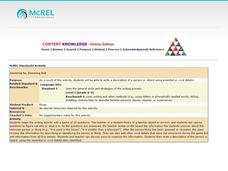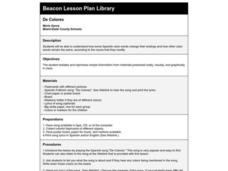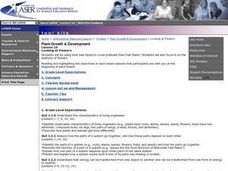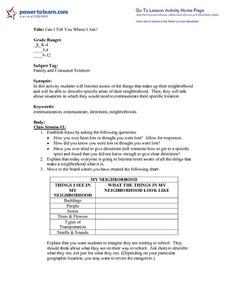Curated OER
Water and Ice
Students explore the physical properties of water. In this water lesson, students observe, measure, and describe water as it changes state. There are 2 extensions for this lesson that one can access via the Internet links provided.
Curated OER
Zooming In, Zooming Out
Students develop their writing skills. In this writing lesson plan, students play a word game to help them formulate a plan to write descriptions of people or objects using descriptive words.
Curated OER
Ratios
Students explore the concept of ratios. In this ratios lesson plan, students use matchbox cars and models of spaceships to explore ratios. Students determine scale for the above mentioned objects in this lecture style lesson plan.
Curated OER
Revealing Process
Students investigate the method of collage in art in part of a study of Dada and Surrealist art. In this art analysis lesson, students explore how artists incorporated materials from everyday life into their art works. Students complete...
Curated OER
Traveler's Trunk
Students analyze and interpret artifacts from the 1920s and explore the Great Migration. In this 1920s history instructional activity, students review background information about the Great Migration and use artifacts to study history of...
Curated OER
Circuits and Conductors
Students explore electricity by completing Internet activities. In this physical science lesson plan, students identify an electric circuit and describe the characteristics of conductors, giving examples as well. Students...
Curated OER
Using Imagery in Poetry
Students examine the use of imagery in poetry. In this literature instructional activity, students read "Thought of Hanoi," by Nguyen Thi Vinhand use the provided graphic organizer to chart the poem imagery. Students then describe the...
Curated OER
Seeing Eye "Buddies"
Third graders observe a variety of sights within their schoolyard habitat and sitting quietly back-to-back with a partner describe what they see. The partner sketches the observations, 3rd graders compare drawings with the object described.
Curated OER
De Colores
Students listen to the song, De Colores, and list the colors heard in the song. They create murals, describe the murals in Spanish, and describe how colors change their endings according to the nouns they modify.
Curated OER
Science: Electric Fields from Point Charges
Students examine electric fields using viewers to discover the direction of positive charges and the location of the field's strength. They experiment with positive, negative, like and opposite charges. Students also describe how...
Curated OER
Ice Cream Blizzards
Fourth graders explore whether the making of homemade ice cream is a physical change or a chemical change in a lab experiment. Students identify states of matter, describe the physical properties of states, and collect temperature data...
Curated OER
Migration Woes
Students are able to describe the reproductive cycle of the gopher frog. They are able to describe the impacts of habitat loss and degradtion on gopher frog populations. Students are explained that many factors limit the survival of...
Curated OER
Multi-sensory Writing
Students use their senses to help describe special place they have been. They write short sensory-image essay that incorporate all five of their senses, and identify sensory language while reading different pieces of literature.
Curated OER
Extending Geometric and Numeric Patterns
Young scholars study patterns. They construct growing patterns using pattern blocks and isosceles right triangles. They verbally describe the patterns and state the rule that describes the relationship involving the number of pattern...
Curated OER
Looking at Flowers
Students use their bee sticks to cross-pollinate their Fast Plants and also focus in on the anatomy of flowers. They analyze how the parts of a system go together, and how these parts depend on each other. Finally, students describe...
Curated OER
Transformations-Shapes on the Move
Students examine transformations. In this math lesson, students view and describe flips, slides, and turns. Students practice making transformations with shapes.
Curated OER
Oobleck
First graders explore Oobleck. They manipulate and observe the properties of Oobleck. Students discuss the differences between solids and liquids. They investigate Oobleck. Students write a sentence describing what they observed about...
Curated OER
Physical vs. Chemical Properties
In this physical and chemical properties worksheet, students read a 2 page article, identify 10 changes as physical or chemical characteristics and decide whether 3 combination of objects are chemical or physical mixtures and explain why.
Curated OER
Heimlich Maneuver
Students read Red Cross handouts on the Heimlich maneuver, then describe and explain all the steps in the Heimlich maneuver. They view a computer simulation of a choking victim, then practice the Heimlich maneuver skills with partners.
Curated OER
Look into Your Future
Students take a examine Community Helpers and the jobs they perform in order to help students explain the responsibilities the job entails. They recognize the community helpers, describe the jobs each performs and how technology is used.
Curated OER
Paleo-Indian Traditions
Seventh graders, in groups, name and describe the three traditions of the Paleo-Indian period.
Curated OER
Find It!
Students analyze the basic concept of Global Positioning Systems using triangulation and measurement on a small scale in the classroom. They describe a satellite and how it helps in locating a person on Earth. They explain how...
Curated OER
The KAO Telescope
Students explore the basic principles of the operation of the NASA's KAO telescope. They construct a simplified model of it using film canisters and other everyday objects. Step by step directions are included in plan.
Curated OER
Can I Tell You Where I am?
Students participate in a instructional activity that is concerned with the factors of describing a neighborhood. They follow a set of target questions in order to obtain information about individual neighborhoods. The information is...























